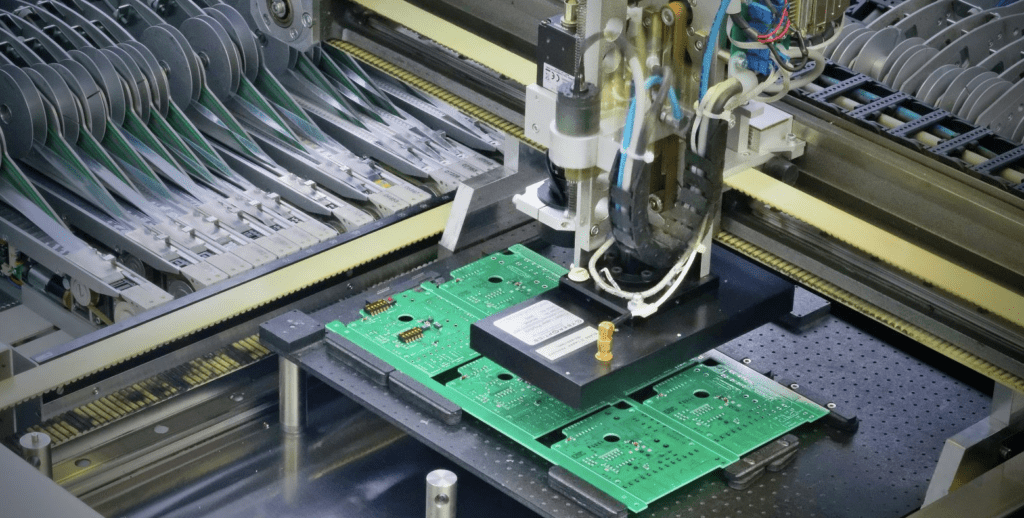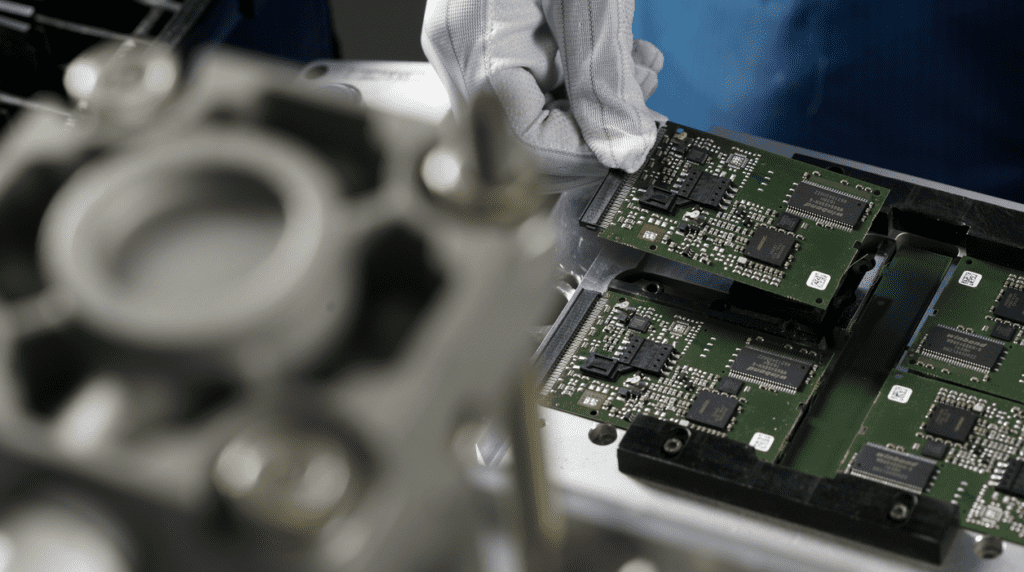SMT (Surface Mount Technology) electronics manufacturing has become a popular method of producing electronic circuits in recent years. This technology involves placing electronic components directly onto the surface of a printed circuit board (PCB), rather than inserting them into holes drilled into the board. This method has several advantages over traditional through-hole technology, including smaller size, higher component density, and faster production times.
One of the main benefits of SMT electronics manufacturing is its ability to produce smaller and more compact electronic devices. With components placed directly onto the surface of the PCB, there is no need for bulky wires or connectors, allowing for a more streamlined design. Additionally, SMT technology allows for higher component density, meaning that more components can be placed onto a single PCB, resulting in a smaller overall size. This is especially important in the development of portable devices such as smartphones and tablets, where size and weight are critical factors.
Another advantage of SMT electronics manufacturing is its faster production times. The process of inserting components into holes drilled into a PCB can be time-consuming and labor-intensive. In contrast, SMT technology allows for automated assembly, where components are placed onto the surface of the board using pick-and-place machines. This method is not only faster but also more accurate, resulting in fewer errors and higher quality products.

Overview of SMT Electronics Manufacturing
What is SMT Electronics Manufacturing?
Surface-mount technology (SMT) is a method of electronic component assembly that involves placing components directly onto the surface of a printed circuit board (PCB) rather than inserting them through holes in the board. SMT electronics manufacturing is the process of assembling electronic devices using SMT techniques.
Advantages of SMT Electronics Manufacturing
SMT electronics manufacturing offers several advantages over traditional through-hole assembly techniques, including:
- Smaller size: SMT components are much smaller than through-hole components, allowing for more compact and lightweight devices.
- Higher component density: SMT components can be placed much closer together on a PCB than through-hole components, allowing for higher component density and more complex circuits.
- Faster assembly: SMT components can be placed on a PCB much more quickly than through-hole components, allowing for faster assembly times and lower production costs.
- Lower cost: SMT assembly requires fewer materials and less manual labor than through-hole assembly, resulting in lower production costs.
Disadvantages of SMT Electronics Manufacturing
Despite its many advantages, SMT electronics manufacturing also has some disadvantages, including:
- Higher equipment costs: SMT assembly requires specialized equipment, such as pick-and-place machines and reflow ovens, which can be expensive to purchase and maintain.
- Limited rework options: SMT components are more difficult to remove and replace than through-hole components, making rework more challenging and potentially more expensive.
- Higher risk of component damage: SMT components are more sensitive to heat and mechanical stress than through-hole components, increasing the risk of damage during assembly.
Overall, SMT electronics manufacturing offers many benefits over traditional through-hole assembly techniques, but also has some drawbacks that must be carefully considered when choosing a manufacturing method.
SMT Manufacturing Process
Solder Paste Application
The first step in SMT electronics manufacturing is the application of solder paste. Solder paste is a mixture of small solder particles and flux. The paste is applied to the PCB (printed circuit board) using a stencil. The stencil is aligned with the PCB and the paste is pushed through the stencil onto the PCB using a squeegee. The solder paste is applied to the areas of the PCB where the components will be placed.
Component Placement
The next step is the placement of components onto the PCB. The components are placed onto the solder paste using a pick-and-place machine. The pick-and-place machine picks up each component from its packaging and places it onto the PCB in the correct location. The pick-and-place machine uses a camera to ensure that each component is placed correctly.
Reflow Soldering
The final step in the SMT manufacturing process is reflow soldering. Reflow soldering is the process of melting the solder paste to create a permanent connection between the components and the PCB. The PCB is placed in a reflow oven and heated to a temperature that melts the solder paste. The oven temperature is carefully controlled to ensure that the solder melts and flows correctly. Once the solder has melted, it cools and solidifies, creating a permanent connection between the components and the PCB.
In conclusion, the SMT manufacturing process involves the application of solder paste, the placement of components, and reflow soldering. This process is used to create high-quality electronic products that are reliable and durable.
SMT Equipment and Tools

Solder Paste Printer
The first step in the SMT assembly process is to apply solder paste to the printed circuit board (PCB). This is done using a solder paste printer, also known as a stencil printer. The printer applies the paste to the PCB through a stencil, which has openings that correspond to the locations where the components will be placed.
Modern solder paste printers are highly precise and can apply paste to very small areas, making them essential for high-density PCBs. They are often automated, with computer-controlled motors that move the PCB and stencil in precise increments to ensure accurate paste application.
Pick and Place Machine
After the solder paste has been applied, the next step is to place the components onto the PCB. This is done using a pick and place machine, which uses vacuum nozzles to pick up the components and place them onto the PCB in their correct locations.
Pick and place machines are highly automated and can place components at very high speeds, making them essential for high-volume production. They also use computer vision systems to ensure that components are placed accurately and that there are no defects in the assembly.
Reflow Oven
Once all of the components have been placed onto the PCB, the board is run through a reflow oven. This oven heats the board to a high temperature, causing the solder paste to melt and bond the components to the PCB.
Reflow ovens are carefully controlled to ensure that the temperature profile is correct and that the solder joints are strong and reliable. They are often equipped with multiple heating zones to ensure that the entire board is heated evenly.
In summary, the SMT assembly process requires a range of specialized equipment and tools, including solder paste printers, pick and place machines, and reflow ovens. These machines are highly precise and automated, enabling manufacturers to produce high-quality electronic assemblies quickly and efficiently.
SMT Quality Control

Visual Inspection
Visual inspection is the most basic form of quality control in SMT electronics manufacturing. It involves examining the components and circuit boards with the naked eye for any defects or abnormalities. This process is usually performed by a trained technician who is experienced in identifying common defects such as misaligned components, solder bridges, and missing parts.
Automated Optical Inspection
Automated Optical Inspection (AOI) is a more advanced form of quality control that uses machine vision technology to detect defects in SMT assemblies. AOI systems use high-resolution cameras to capture images of the components and circuit boards, and then analyze those images using sophisticated algorithms to identify defects such as missing components, misplaced parts, and solder defects.
X-Ray Inspection
X-Ray Inspection is a non-destructive testing method that is used to inspect the internal structure of SMT assemblies. X-Ray machines are used to generate images of the circuit board and components, which can then be analyzed to detect defects such as voids in the solder joints, cracks in the components, and other internal defects that may not be visible with other inspection methods.
In conclusion, SMT quality control is an essential part of the electronics manufacturing process, and it involves a variety of inspection methods to ensure that the final product meets the required quality standards. Visual inspection, AOI, and X-Ray inspection are some of the most commonly used methods in SMT quality control, and each method has its own advantages and limitations. By using a combination of these methods, manufacturers can ensure that their products are of high quality and meet the expectations of their customers.
SMT Industry Trends

Miniaturization of Components
The trend towards miniaturization of components in SMT electronics manufacturing continues to accelerate. This trend is driven by the need for smaller and more portable electronic devices, such as wearables, IoT devices, and medical implants. As a result, SMT manufacturers are investing in new equipment and technologies to enable the production of smaller and more complex components. This includes the use of advanced materials, such as nanomaterials and graphene, to create more compact and efficient electronic components.
Advanced Packaging Technologies
Another trend in SMT electronics manufacturing is the adoption of advanced packaging technologies. These technologies enable the creation of smaller and more complex electronic devices by integrating multiple components into a single package. This includes the use of 3D packaging, which allows for the stacking of multiple layers of components, and system-in-package (SiP) technology, which integrates multiple components into a single module. These advanced packaging technologies enable the creation of smaller and more powerful electronic devices, while also reducing the overall size and weight of the device.
Smart Manufacturing
Smart manufacturing is another trend in SMT electronics manufacturing. This involves the use of advanced technologies, such as artificial intelligence (AI), machine learning, and the Internet of Things (IoT), to optimize the manufacturing process. Smart manufacturing enables SMT manufacturers to improve efficiency, reduce waste, and increase productivity by automating processes, monitoring equipment performance, and analyzing data in real-time. This trend is expected to continue as SMT manufacturers seek to improve their competitiveness and meet the growing demand for smaller and more complex electronic devices.
In conclusion, the SMT electronics manufacturing industry is experiencing several significant trends, including the miniaturization of components, the adoption of advanced packaging technologies, and the implementation of smart manufacturing. These trends are driven by the need for smaller and more powerful electronic devices, and are expected to continue in the coming years.

